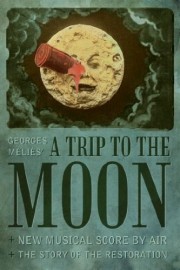A Trip to the Moon (Short)
Of all of the films in history that have been parodied by the likes of “The Simpsons,” “Futurama,” “South Park,” and anyone else interested in tickling the audience’s funnybone, I’d be willing to bet that Georges Méliès’s most famous film, “A Trip to the Moon,” is the one most often parodied, but likely, never really seen. We all know the famous image of a rocket crashing into the eye of the man on the moon, but what about the remaining eleven-plus minutes of the film?
After Martin Scorsese’s “Hugo,” I decided that it was time for me to watch the film myself. Widely considered the first science-fiction film, Méliès had the know-how as a magician to make the impossible seem possible, and the energy and sense of fun to make it come alive in an entertaining and unforgettable way. The story is simple enough– a group of elders take a rocket to the moon, and discover the creatures and beings living on it –but it’s the images that make the film a singular treat, and while “Hugo” gives us hints as to how Georges Méliès may have created his art, a magician in the world of cinema never really reveals his secrets. That elusive sense of mystery as to how, in 1902, Georges Méliès and his collaborators made this “Trip to the Moon” happen remains with the movie to this day, and even considering all of the advances in technology that exists for today’s master illusionists, cinema’s original purveyor of fantasy and wonder still towers over them all thanks to his boundless imagination.
Author’s Note: I’ve also decided to watch more of Georges Méliès’s films than just “A Trip to the Moon,” and I have reviewed two of them for Sonic Cinema. They are “The Mermaid” and “The Impossible Voyage”. I hope you decide to reads those as well, as seek out the films for yourself. Even 100-plus years after their creation, they remain a singular experience.
Some more thoughts about “A Trip to the Moon,” written recently for a class in Language of Film & TV:
With “A Trip to the Moon,” Georges Méliès moves past the early moving picture experiments by Edison and the Lumiere Brothers to tell a story of pure fantasy. He does this from a narrative standpoint by telling a linear story about a group of scientists deciding to travel to the moon; having the rocket built; being sent off as champions of humanity, only to see themselves greeted by the moon life as enemies, before being forced to return home, where they receive a warm reception after splashing down. Visually, however, is where Méliès’s film really soars in the imagination, and I will provide examples in set design and performance that show the genius of Méliès’s accomplishments as a visual storyteller.
In terms of moving from scene to scene, “A Trip to the Moon” is nothing more than isolated shots (no moving camera, although when we see the moon before the iconic moment when it’s “face” is hit by the rocket, the moon moves into the foreground, giving the illusion of movement), with each one depicting a moment in the trip, starting at the conception of the idea between scientists and thinkers, and concluding with what appears to be a parade when the men return home. Each shot is a specific setup, and the film transitions between each setup/shot by simply cutting to the next shot, although there are a couple of dissolves used if moving between shots with common backgrounds. The backgrounds appear to be a combination of sets and matte paintings, which aids in giving the images depth and a sense of wonder that transcends even the mundane acts of the scientists changing into their dress clothes after they decide to go to the moon, or looking out over the city before their launch. Watching the film 112 years later, we live in a world where man has been to the moon, and walked on the moon, so we know that the image Méliès provides of the moon, with it’s underground dwellers and plant life, is the work of pure fantasy, but ever the magician, Méliès is more concerned with inspiring awe than reflecting reality, which is one of the cornerstones of the sort of special effects-driven cinema Méliès foreshadowed with his work.
Because there are no title cards with explanations or dialogue, Méliès had to rely on his visuals to tell the story. (I’ve never actually seen a print of the film with narration. I skipped over watching the version embedded with this lesson because I recently bought the Blu-Ray restoration.) This results in performances by the actors that are full of exaggerated hand gestures and pantomimes- nowadays, we would consider this overacting, but it feels very much at home with the tale of fantasy Méliès is telling, and is important to the success of the film once the main characters find themselves on the moon, and encounter dangerous creatures who are ready to attack them.
“A Trip to the Moon” is a wondrous achievement in storytelling to this day, and I can only imagine what it must have felt like when it was first released. (I have a feeling Scorsese’s “Hugo” gives us a glimpse, though, when the young protagonist describes watching the film to his new friend.) The use of elaborate set design and exaggerated physical performances are married with creative effects (such as when the scientists dispatch of a moon creature, and it goes up in a puff of smoke, or when one of the scientists sticks their umbrella in the ground of the moon, and it sprouts into a mushroom) that may seem primitive, and a little ridiculous, compared to the photorealism today’s filmmakers are capable of, but nonetheless work hand-in-hand to tell a coherent story from beginning, middle, and end.










